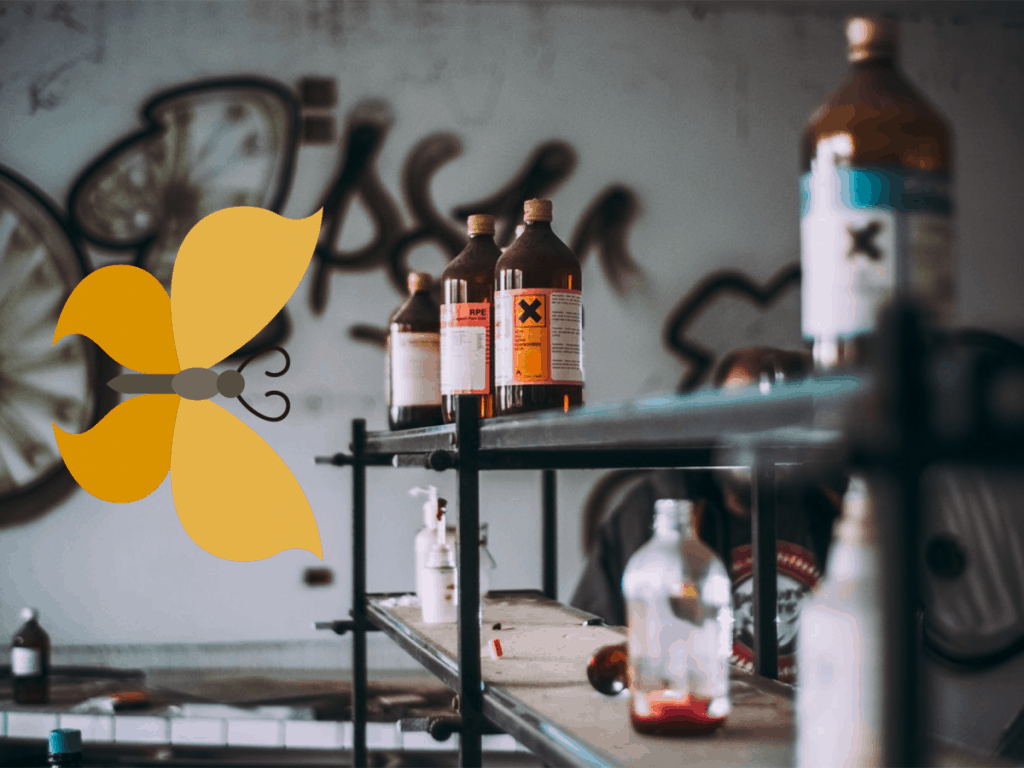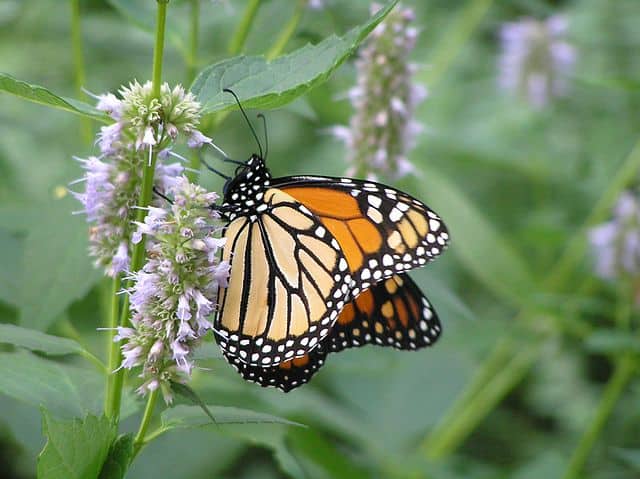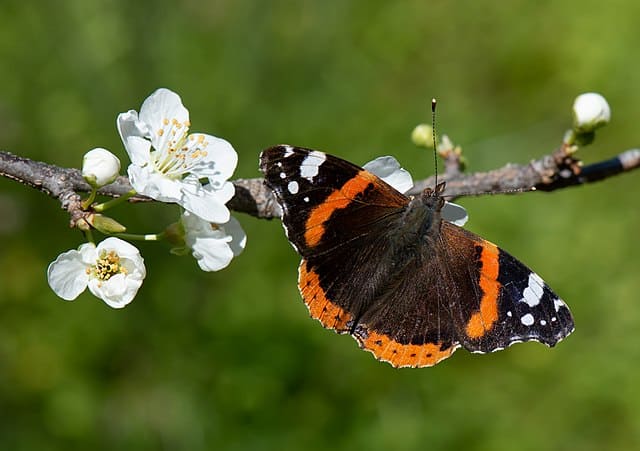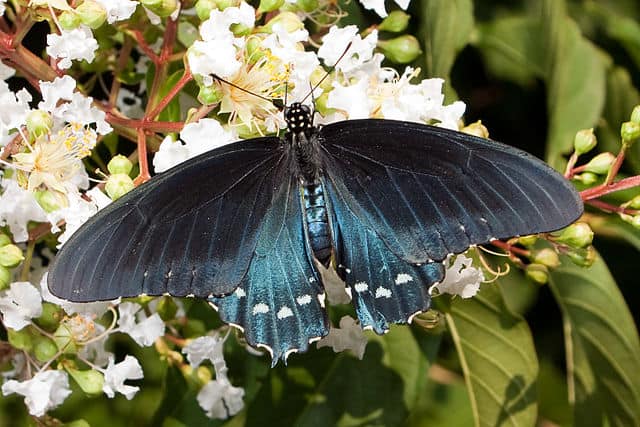
Butterflies Can Be Poisonous?
Generally in life, when we see butterflies, the common knowledge is to not touch them as they are fragile and our body’s oils can harm them in addition to our strong fingers smushing up their bodies (which is just a shame). But, if they’re so delicate how can they possibly survive being preyed-on by bigger animals and bugs?
Well, a number of butterflies actually have evolved to be poisonous.
The interesting part is, butterflies typically get the poison from the plants they eat as caterpillars – which are sometimes toxic. They then accumulate these toxins and they remain in the adult butterfly’s body, even though its diet changes.
Merely touching them with a hand (or paw) won’t harm you, but if you try and take a bite out of a poisonous butterfly, you’ll regret it!
Let’s examine via a Q&A format how certain butterflies can be poisonous to humans and animals, as well as which specific species should be avoided by us or our furry friends.
How Can Butterflies Be Poisonous to Humans?
Butterflies are very unlikely to harm humans (or any other mammal for that matter) because their physiology simply doesn’t allow it. They are simply not designed to fight or do any harm. Butterflies don’t have stingers, fangs, a mouth with teeth, or basically anything else that would allow them to inject their venom into another living being. That’s why we say butterflies aren’t venomous.
But, they can be poisonous in another sense – that is, if another creature tries to eat them. So what would happen if a human tries to eat a butterfly?
The way our sense of taste works we know that if something tastes awful, that generally means we should not eat it. Often, a bad taste can indicate something is poisonous, and that is true with a number of kinds of butterflies.
While people these days may not eat butterflies too often outside of some Spanish and Southeast Asian cultures, those individuals are well aware that while a number of butterflies may taste pretty good in their opinion, everyone can agree some species of butterfly are purposely nasty to prevent anyone from eating them!
However, it’s worth mentioning that even if a human decided to eat a nasty-tasting butterfly, this is unlikely to cause any serious harm. The poison inside the butterfly is unlikely to be strong enough, and there are no known cases of humans dying from butterfly poisoning.
Now, as people don’t eat butterflies too often, the bigger concern is if these butterflies can be poisonous to things like birds, cats, and dogs.
Are Butterflies Poisonous to Animals Like Birds, Cats, and Dogs?
Even though animals have digestive systems that are able to handle quite different food than humans (we generally shouldn’t eat birdseed, for example), it holds true that any butterfly which could make us retch in disgust will also upset the tummy of a bird, cat, dog, or other beloved pet.
Usually, if an animal bites a poisonous butterfly it will quickly realize it has made a terrible mistake and do its best to spit the butterfly out. A pet or wild animal swallowing and trying to ingest one of these poisonous butterflies won’t be fatal, but may result in vomiting, diarrhea, and generally feeling crummy for some hours.
Most animals realize which butterflies are a no-go, but it is still advisable to keep them away from butterflies that could be an issue. This leads to the question, which butterflies are poisonous?
Are Monarch Butterflies Poisonous?

Monarch butterflies are gorgeous. Their bright orange coloration makes them easy to spot and admire. You’d think being so noticeable would be a risk, but it actually is an important tool for the Monarch’s survival!
Its bright colors serve as one big warning sign to potential predators, with that sign being, “Don’t eat me, I taste terrible!”
How does this happen? Well, much how the things we eat when we are kids can help us grow up big and strong when the Monarch butterfly is still a lowly caterpillar it feasts on milkweed and other, “cardenolide-producing,” plants. These plants are poisonous to most who would try to eat them, but this insect is able to tolerate it and loves chowing-down on the stuff.
All of this milkweed enters into the caterpillars’ system and then it spends about a month in a cocoon turning into a beautiful Monarch butterfly. All that milkweed it ate when young results in it having a nasty and foul taste, not unlike milkweed itself should any critter try and eat it.
Generally, if an animal doesn’t know better and actually attempts to swallow a Monarch butterfly, it learns its lesson and never tries to do that again! The bright colors the Monarch butterfly sports serve as a big metaphorical hazard sign to everyone that trying to eat it will be a big mistake.
Are Red Admiral Butterflies Poisonous?

Often found during the Springtime, Red Admiral butterflies (AKA Red Admirable or Vanessa atalanta) are one of the most widespread species around. You can find them on six continents (Antarctica is much too cold) with their red, black, and white coloration being extremely eye-catching.
Now, you may be thinking with Monarch butterflies being brightly colored and poisonous the Red Admiral is too…but you’d be wrong! Red Admiral butterflies are actually perfectly safe to handle or consume as caterpillars and adult butterflies.
Their coloration may have more to do with mating, and they are capable of fast and, “strong,” and erratic flying that allows them to avoid potential predators. Even if the red looks like a warning, Red Admiral butterflies are actually perfectly safe to ingest.
Are Pipevine Swallowtail Butterflies Poisonous?

Pipevine Swallowtail butterflies are another gorgeous insect. Bright blue with specks of orange and white, they are quite a sight. They also are quite poisonous. Much like how the Monarch butterfly will eat a toxic plant whilst in its caterpillar stage, the Pipevine Swallowtail butterfly loves to feast upon Aristolochia (also known by the name pipevine, birthwort, and Dutchman’s pipe).
Normally the toxins in this plant would make someone extremely sick, but not these caterpillars. They eat so much that upon finishing their cocoon stage and becoming a fully-grown butterfly they are extremely toxic to any person or animal who might dare try to eat them.
The caterpillars have bits of bright red and the eggs even look brick red too. This butterfly isn’t trying to hide–if anything it works to make itself more visible so as to warn anyone who might potentially think it looks tasty, “Stay away, I am incredibly nasty if you try and eat me.”
Which Other Butterflies Are Poisonous?
So far we’ve covered the 3 most common butterflies that are thought to be poisonous, but there are some other less known species from around the world that also carry a dose of poison. These are some of them:
Postman Butterfly
The Postman Butterfly (Heliconius melpomene) is found in certain parts of Central and South America. It is recognizable by its long wings with an orange stripe on each predominantly black wing. These butterflies eat passion flower vines in the caterpillar stage which makes them toxic for the rest of their lives.
Red Lacewing
The Red Lacewing (Cethosia biblis) is another butterfly whose caterpillars feed on toxic plants (mainly various Passiflora species in this case). This, in turn, makes the adult butterfly taste iffy if something tries to eat it.
This butterfly can be recognized by its large wingspan (over 3 inches) and the red, white, and black patterns on the wings. The Red Lacewing is found in certain parts of South and Southeast Asia.
Zebra Longwing
The Zebra Longwing (Heliconius charithonia) butterfly is easy to recognize by the zebra-like pattern on its wings. Just like the Red Lacewings caterpillars, the caterpillars of Zebra Longwing butterflies feed on passion vines which contain toxins. This butterfly is mainly found in Central and South America.
Zebra Longwing is also the official state butterfly of Florida.
Atala Butterfly
The Atala butterfly (Eumaeus atala), also known as Coontie Hairstreak, has large dark wings with iridescent blue patterns. Caterpillars of these butterflies feed on plants called cycads which contain a potent liver toxin called cycasin. These butterflies can be found in Florida, Cuba, and some nearby islands.
Common Indian Crow
The Common Indian Crow Butterfly (Euploea core) feeds on a large number of plants as a caterpillar, including many which are toxic, like oleander, for example.
Giant African Swallowtail
The Giant African Swallowtail (Papilio antimachus) is known primarily for being huge – its wingspan ranges from 7 to 9 inches! But, it is also often called the world’s most poisonous butterfly.
It is believed that the toxicity of this butterfly comes from a toxic vine the larvae feed on, but, interestingly, scientists still haven’t caught an actual Giant African Swallowtail caterpillar in the act of eating – so we don’t know what exactly makes them toxic.
What Are, “Mimic Species,” and Are They Poisonous?
Mimicry is a concept in nature where one species of animal will try to actively copy another in order to be safe.
A number of butterflies engage in mimicry. One notable example is the aptly-named Owl butterfly which has wings that look a lot like a large owl’s imposing eyes. Appearing to be a big owl is a great way to scare away predators that are bigger than a butterfly (mice, for example), but much smaller than a ravenous owl. Mimics will actually imitate other butterfly species as well, however.
There are a number of butterfly species that closely resemble the Monarch butterfly without actually being poisonous to ingest.
One such butterfly is the Viceroy. The interesting thing about mimics is that they really depend on a large number of the animal they are in fact imitating to be around, or else their mimicry will be useless. After all, if you walked around in a bear costume in a town with no bear population like New York City, people would know you were just someone dressed-up to be silly.
Wearing such a costume in a rural town, however, will probably scare everyone a great deal! That makes it really necessary for the Viceroy to have Monarchs around or the Owl butterfly to be able to count on real owls to scare threats away as well. Basically, while mimics themselves may not be poisonous or dangerous, they rely on butterflies that actually do pose a danger to scare away predators from trying to eat them!
Can You Die From a Poisonous Butterfly?
So far in all discussion of butterflies being poisonous, the focus has been on how they will make humans or animals such as birds and cats very sick if ingested. Is it actually possible for a creature to die from a poisonous butterfly, however? The answer is, “No,” but with one technicality.
There is a moth (moths being relatives of butterflies) called the, “N’gwa or ‘Kaa,” which has extremely toxic body fluids.
It is found in Africa and some tribes will actually smash them up and use the residue to coat arrow tips. These arrows are then used to shoot and kill antelope.
Theoretically, a small human could die from this, but there is no recorded instance of such a thing. So, the closet you can come to dying from a butterfly is the caterpillar form of a moth located in Africa. In other words, you don’t need to worry about a butterfly killing anyone in the near future.
Butterflies: Look, but Don’t Touch (or Eat)!
It should be obvious now that while all butterflies are fun to look at and admire, you shouldn’t touch them because they usually won’t survive any accidental damage you may cause, and you really should not eat them unless you are sure what kind of butterfly you’re about to make a meal out of!
A number of butterflies are perfectly safe to eat, and some that are safe even will mimic the poisonous kind in an effort to stay safe, but when in doubt you and your pets should be cautious. Butterflies can be poisonous, but as long as you don’t put them in your mouth (or your pet’s mouth) everything should be a-okay!
Sources
Recent Posts
Tiny Black Bugs in Bathroom NO WINGS: What They Are and What to Do!
Finding tiny black bugs in your bathroom can be uncomfortable, to say the least. Especially if they are persistent, or they appear in very large numbers, which they often like to do. When it...
Tiny Black Bugs in Plant Soil - What Are They & What To Do About It
A short horror story: You get a new houseplant. You do your best to take care of it. You’ve ensured that it has the right soil, the right amount of sun, it gets enough water. And then one day, you...

